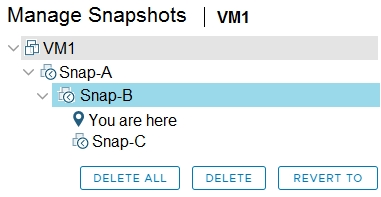Refer to the exhibit.

Which two statements are true regarding the state of the virtual machine (VM) if an administrator clicks the `Delete All` option? (Choose two.)
Refer to the exhibit.

Which two statements are true regarding the state of the virtual machine (VM) if an administrator clicks the `Delete All` option? (Choose two.)
When the 'Delete All' option is clicked in the snapshot manager, all the snapshots listed are consolidated into the base disk, and all snapshots are removed from the virtual machine. This means no snapshots will remain on the VM, making option B correct. As for the state of the VM, it will revert to Snap-A because the 'You are here' marker indicates that the current state is a child snapshot of Snap-B, and merging all snapshots will revert the VM to the state of Snap-A, making option E correct.
Clicking *Delete* commits the snapshot data to the parent and removes the selected snapshot. Clicking **Delete All** commits all the immediate snapshots before the "You are here" current active state to the base disk and "removes all existing snapshots for that virtual machine". https://kb.vmware.com/s/article/1009666
This image shows this VM was reverted to an earlier snapshot. Anything after the "you are here" will not be committed to base disk when "Delete All" is chosen and there for is deleted.
B&D....https://docs.vmware.com/en/VMware-vSphere/7.0/com.vmware.vsphere.vm_admin.doc/GUID-542CF191-B8DE-42F1-9CCC-D9030491AE25.html
Answer is BD. I tested it, when you revert to snapshot B, it takes "you are here" definition below snap-b. So the vm state is equal to snap-b.
The Answer is B and D. I have just tested this on a VM and the state of the VM remains the same as Snap B (the one with You are Here below it), but all snapshots are cleared.
A and B are corrects https://kb.vmware.com/s/article/1009666 Note: Clicking Delete All commits all the immediate snapshots before the You are here current active state to the base disk and removes all existing snapshots for that virtual machine.
https://kb.vmware.com/s/article/1009666
BD Correct
This question is technically incorrect. Whilst the answer is obviously meant to be B & D, the current VM state does not match Snap-B, as that could have been taken months (or years) ago. The VM state is actually represented by "You are here" which is a different point in the Snapshot chain and (if you look at the underlying disk files) is represented by a different delta vmdk, than Snap-B. At this point Snap-B is read only and all changes since it was taken (which as above, could be months or years) are actually writing to the "You are here" delta disk. So answer B&D, but not a correctly written question IMO
My answer is B & D. There is no snapshots remain for DELETE ALL. VM state will match Snap-B. Snap C will be ignored.
https://docs.vmware.com/en/VMware-vSphere/7.0/com.vmware.vsphere.hostclient.doc/GUID-06CB6D7D-9ECE-4C53-AA11-C5F2662328CD.html. Use the Delete All option to delete all snapshots from the Snapshot Manager. Delete all consolidates and writes the changes that occur between snapshots and the previous delta disk states to the base parent disk and merges them with the base virtual machine disk.
BD is correct
BD Correct Passed 500/500 Today 1-Dec-22
B is incorrect. Delete All deletes all snapshots, regardless of how many are there or what the client has clicked.
... managed to f.ck up, so D is incorrect and B is only correct.
Why sanpshot B
"You are here" is under the snapshot B
When your vm is working on a snapshot, you are here and you click delete it will merge that snapshot to the previous one, in this case Snaphshot A will merge to VM Disk, then Snapshot B will merge to VM and Snapshot C will be deleted as it is after the B Snapshot. So the state of the VM is Snapshot B and there will be no snapshots that will remain.